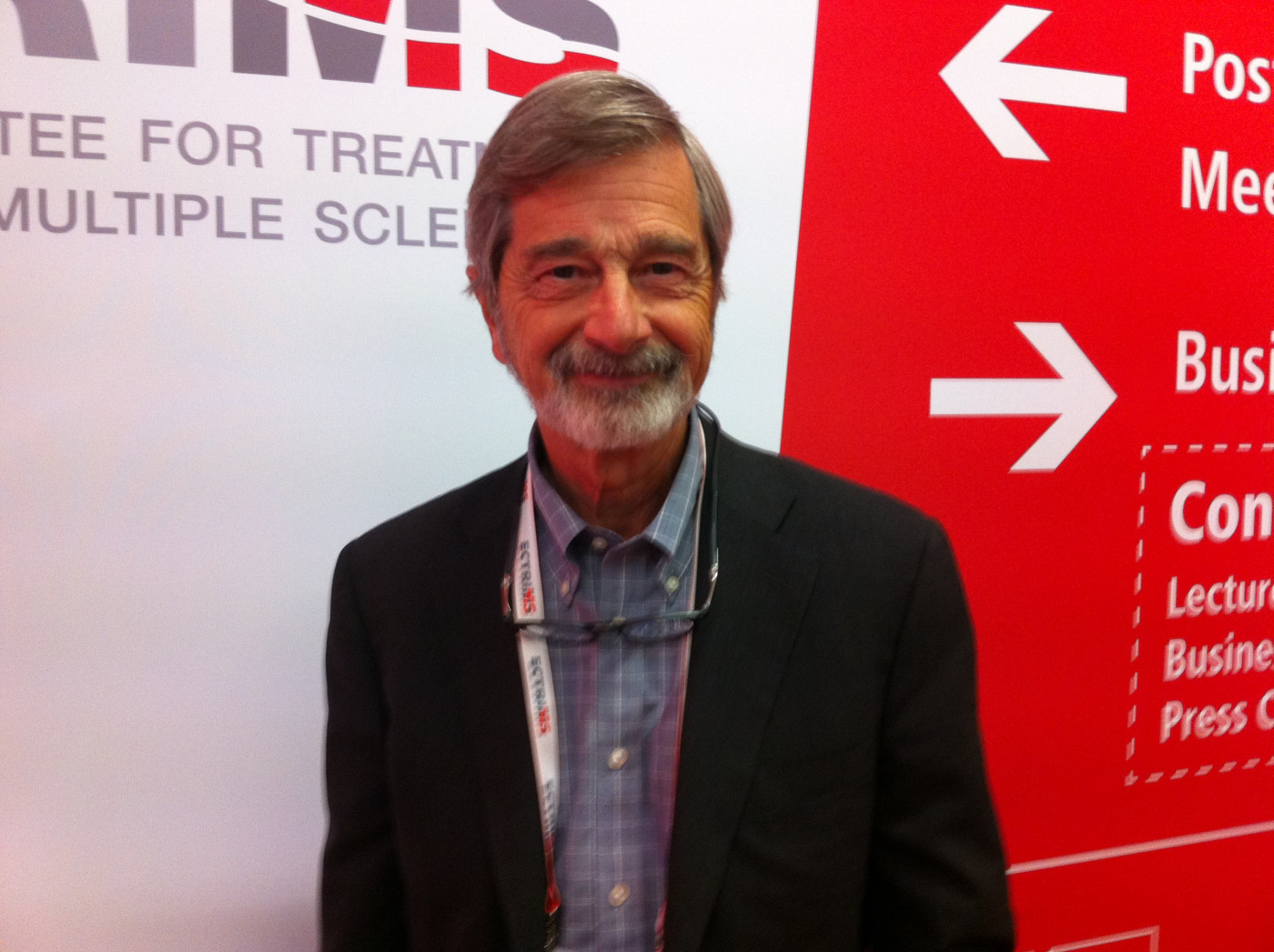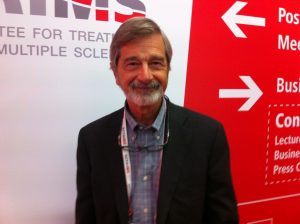#ECTRIMS2018 – Evobrutinib and Other Reasons for Hope in Pursuit of MS Treatments, Jerry Wolinsky Says in Interview

Jerry Wolinsky, professor emeritus in the Department of Neurology at UT Health in Houston. (Photo by MS News Today)
Advances in multiple sclerosis research and the development of new treatments over the last several decades give sustained reasons for hope as continue moving toward our future, according to Jerry S. Wolinsky, a neurologist and MS specialist whose career spans more than 40 years.
In a wide-ranging interview with Multiple Sclerosis News Today at the recent 34th congress of the European Committee for Treatment and Research in Multiple Sclerosis (ECTRIMS), Wolinsky discussed the latest findings on evobrutinib, current therapeutic strategies in MS, as well as potential new targets and their challenges.
Wolinsky is a professor emeritus in the department of neurology at the McGovern Medical School, The University of Texas Health Science Center at Houston (UTHealth). He is past chair of the Research Programs Advisory and National Medical Advisory Committees of the National MS Society, and a past president and emeritus board member of the Americas Committee for Research in Multiple Sclerosis (ACTRIMS).
Evobrutinib and a potential ‘on-off switch’
The development of disease-modifying therapies (DMTs) for MS started with formulations of interferon — currently sold under trade names such as Rebif (by EMD Serono), Avonex (by Biogen), and Betaferon/Betaseron (by Bayer) — and glatiramer acetates like Copaxone by Teva Pharmaceuticals, and Glatopa by Sandoz.
Although not in a predictive way, the initial studies with interferon and glatiramer acetate “have taught us a lot about who does respond and who doesn’t respond,” Wolinsky said, “but most importantly, we know a lot about their safety. And so, if anything, they to me become the hurdle to clear in terms of safety for the subsequent drugs.”
These newer therapies generally show themselves to be superior, “but maybe not safer” than those first approaches. Later immune-targeting antibodies also demonstrated high efficacy in general, but with different side effect profiles — all of which need to be considered in treating a person.
“So, yes, there’s a lot of decisions to make about picking and selecting the right drug for the right patient at the right time. And I’d be foolish if I’d tell you I could give you the right formula, because that would mean I don’t know enough to be confused by what’s out there,” Wolinsky said.
Investigational therapies now in development on the ability to halt inflammatory attacks, which possibly underly the development of brain lesions and mechanisms that damage the brain.
“So then, that could bring me to something like evobrutinib,” Wolinsky said.

Jerry Wolinsky, professor emeritus in the Department of Neurology at UT Health in Houston. (Photo by MS News Today)
Evobrutinib is an oral inhibitor of a protein known as Bruton’s tyrosine kinase, which is key for the development and functioning of various immune cells, including B-cells and macrophages. Besides B-cells and their interaction with T-cells, evobrutinib may also impact microglia — key cells in immune responses to infection or injury — and other cell types.
Updated data from a Phase 2 trial (NCT02975349) evaluating the safety and efficacy of evobrutinib in patients with relapsing MS were presented as late-breaking news at ECTRIMS, in a presentation titled “Primary analysis of a randomised, placebo-controlled, phase 2 study of the Bruton’s tyrosine kinase inhibitor evobrutinib (M2951) in patients with relapsing multiple sclerosis.”
The study revealed that once-daily and twice-daily evobrutinib, 75 mg, significantly reduced the number of T1 lesions and new or enlarging T2 lesions measured at weeks 12, 16, 20, and 24. T1 and T2 are technical terms used for different MRI methods; a T1 image offers information about current disease activity by highlighting areas of active inflammation, while a T2 image provides information about disease burden or lesion load (the total amount of lesion area, both old and new).
Evobrutinib, being developed by Merck KGaA (EMD Serono in North America), was also shown to lead to a numerical and clinically relevant decrease in the annualized relapse rate in relapsing MS patients at 24 weeks after treatment start.
Earlier results of the study had already shown a significant lessening of brain and spinal cord lesions in these patients, compared with a placebo.
“We think we have pretty good data, excellent data, that [evobrutinib] affects B-cell activation. That it does it through a mechanism which is not destructive of the cell population as a whole,” Wolinsky said. Evobrutinib, he added, seems to deactivate the cells by altering the profiles of molecules at the cell surface, as well as the release of inflammatory mediators called cytokines, “and can be used — theoretically — under the control of a switch.”
This means that “if you throw the switch off,” Wolinsky said, “within about five days or so, you’re likely to see that those cells that are … surviving, but not carrying out — in a sense — their luxury [B-cell] functions” can become functional again, returning to their normal activity to “hopefully restore” B-cells and macrophages.
If evobrutinib is able to reach the brain, as available data indicate, it may also affect slowly expanding lesions by controlling innate cells or favoring the anti-inflammatory phenotype (called M2) of microglia in a way not possible with antibodies, which have very limited ability to pass the blood-brain barrier.
Overall, even though more analyses — including into 48-week data — still need to be conducted, including in patients with secondary progressive multiple sclerosis (SPMS), the trial shows that evobrutinib has an effect on inflammatory-mediated lesions. Although not designed to address such effects, findings to date also show a strong trend toward a lower immune attack rate.
“So for the number of patients in this trial and the length of the study, [results] point … that this is a pretty good signal,” Wolinsky noted.
Much is still to be found regarding evobrutinib’s mechanism of action, but Wolinsky believes it may be superior to options exclusively targeting B-cells and immune reconstitution, such as Sanofi Genzyme’s Lemtrada. This treatment, although more broadly active, may carry “a set of problems with it that frankly I don’t think we anticipated from the anti-B-cell therapy for evobrutinib.”
As for safety results, an elevation in liver enzyme levels was seen in evobrutinib-treated patients, but “seemed to be reversible,” Wolinsky said.
“It’s years behind having enough signals to know that you really have a clean drug, but this is how you start,” he added. “So no, I’m not worried about [safety] signals thus far, or putting patients into the trial. I think there’s some potential here.”
Wolinsky also noted that the 75 mg evobrutinib dose “is probably as high as we should go.”
‘Phenomenal time’ to be working in MS
A neurologist who began to focus on MS in the mid-1970s and was involved in the development of current DMTs, Wolinsky notes that while “the younger generation takes all these [advancements] for granted,” the “older generation just looks at it skeptically, saying, ‘well you still haven’t found out the cause. And if we can’t find out the cause, we’ll never know the treatment and we’ll never be able to eliminate it.’”
“I think that’s all true,” he said. “But we’re managing it extraordinarily well now, and with the hope that we can do better.”
In all, this is “a phenomenal time for the world I ended up getting deeply interested in.”
Wolinsky’s group has been developing an independent side project looking at a way to possibly improve blood flow in the brain of MS patients. Flow alterations occur very early in disease process, Wolinsky said, becoming more prominent over time, and are associated with lesion load.
Scientists know that they can change blood flow in the MS brain. “We’re now at the point of saying, ‘OK, now we want to know with really more sophisticated approaches to imaging, … whether we can prevent [brain] tissue from showing increasing loss of tissue integrity,’” he said.
Wolinsky also emphasized the need of new approaches to properly assess “the more novel therapies.” Noting work done on MediciNova’s ibudilast, he said that trials combining different strategies, and assessing mechanisms of action and different levels of efficacy, are the most likely research directions to follow.
As for stem cells or bone marrow replacement, Wolinsky, who has been involved in MS research since the “very early trials,” said simply that more “tangible progress” had been achieved with medications.
“I would love to say that really we’re all waiting for stem cells,” he said. “But I think it’s going to be a wait until we understand really how the cells are harvested, how they’re manipulated, what’s the best way to do it, and how’s it best dosed. Does it really do anything more than immunomodulation?”
‘Real-world’ data informing risks
Despite extensive preclinical and clinical research, assessing medications’ safety and risks is a continuous process requiring years of trial follow-up and clinical practice.
As an example, Wolinsky pointed to Biogen’s Tysabri (natalizumab), which showed great results “through the first analysis of the data and the first paper,” but “it wasn’t for at least three weeks until the first PML case emerged.” PML stands for progressive multifocal leukoencephalopathy, a brain infection caused by the JC (John Cunningham) virus.
Investigators then did a “great job” in establishing how to determine the PML risk for a given patient, based on whether the JC virus was present. “That risk stratification helps,” Wolinsky said, “but it also says there are things out there that you may not be aware of when you are first bringing out a drug — even out of relatively large clinical trials.”
He also mentioned the B-cell targeting therapy Ocrevus (ocrelizumab, by Genentech), which raised early concerns of an increased breast cancer risk. While “we need to be concerned about” safety signals that yet might arise, “I’m not sure we need to be worried about” them, Wolinsky said, noting “the breast cancer [risk] is probably really within the range that we would expect in women of that age group with or without MS.”
With Ocrevus coming into use in large numbers of patients — an estimated 60,000 new users — “the big wave behind us will tell us what the real risk is,” he said.
Looking back at the advances realized in MS, Wolinsky concluded: “The tough part is making sure we don’t pull the rug out under hope, and truthfully, I don’t think anyone can do that anymore because we’ve come so far.”






